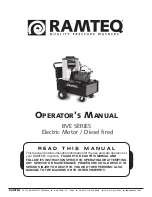
32
3. Place the five covers (from the acces-
sories bag) onto the openings in the
rear panel and use a suitable tool
(such as the handle of a screw driver)
to push them into place. The smaller
cover is intended for the top-mot
opening.
Store the transit bars in a safe place.
• They will be required if the washing
machine is to be transported again
(e.g. if you move house).
A
Never transport the appliance without
installed transit bars!
The right location of installation
Install the appliance in a stable, level posi-
tion in frost-free surroundings.
A
If there is danger of frost, drain all re-
maining water (see "Care and mainte-
nance").
A
The floor must have sufficient load-
carrying capacity!
If, for example, the washing machine
and a dryer are stacked upon each
other, they can – when loaded – have
a total weight of up to 180 kg.
Important:
• Do not stand appliance on the power
cable.
• Keep at least 1cm distance to walls of
other furniture.
• Place the machine on a firm surface,
never on a long-pile carpet or similar
surface.
Levelling the machine
A
Don't use a tool to loosen the lock
nuts to avoid damaging them.
1. Loosen the lock nuts on the feet.
2. Adjust the feet until the machine is
level and stands steady.
3. Important: Retighten all lock nuts.
Connecting the water supply
The machine can be connected to water
taps with 3/4 inch BSP thread.
Important:
• Bear the permissible water pressure in
mind (see "Technical specifications").
Attach a pressure reducing valve if wa-
ter pressure is higher.
• Do not connect to a water heater (in-
stantaneous water heater or unpressu-
rised boiler), as the water pressure is
insufficient.
• Check with customer service for hose
extensions. Do not use homemade ex-
tensions with hose clamps or similar!
• Use only the new hose supplied with
the machine, not an old existing one!
• Ensure that there are no sharp bends
in the hose!
A
Do not use a tool to tighten it.









































